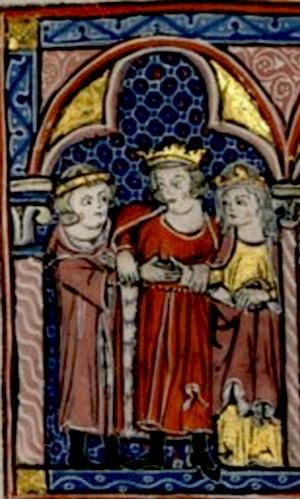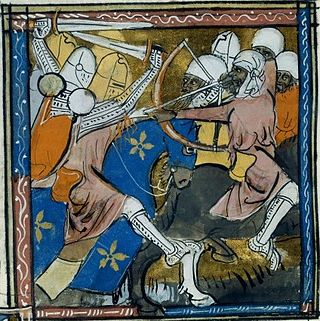Related Research Articles

Aimery of Lusignan, erroneously referred to as Amalric or Amaury in earlier scholarship, was the first king of Cyprus, reigning from 1196 to his death. He also reigned as the king of Jerusalem from his marriage to Isabella I in 1197 to his death. He was a younger son of Hugh VIII of Lusignan, a nobleman in Poitou. After participating in a rebellion against Henry II of England in 1168, he went to the Holy Land and settled in the Kingdom of Jerusalem.

Baldwin I was the first count of Edessa from 1098 to 1100 and king of Jerusalem from 1100 to his death in 1118. He was the youngest son of Eustace II, Count of Boulogne, and Ida of Lorraine and married a Norman noblewoman, Godehilde of Tosny. He received the County of Verdun in 1096, but he soon joined the crusader army of his brother Godfrey of Bouillon and became one of the most successful commanders of the First Crusade.

Bohemond II was Prince of Taranto from 1111 to 1128 and Prince of Antioch from 1111/1119 to 1130. He was the son of Bohemond I, who in 1108 was forced to submit to the authority of the Byzantine Empire in the Treaty of Devol. Three years later, the infant Bohemond inherited the Principality of Taranto under the guardianship of his mother, Constance of France. The Principality of Antioch was administered by his father's nephew, Tancred, until 1111. Tancred's cousin, Roger of Salerno, managed the principality from 1111 to 1119. After Roger died in the Battle of the Field of Blood, Baldwin II of Jerusalem took over the administration of Antioch. However, he did acknowledge Bohemond's right to personally rule the principality upon reaching the age of majority.

Baldwin II, also known as Baldwin of Bourcq or Bourg, was Count of Edessa from 1100 to 1118, and King of Jerusalem from 1118 until his death. He accompanied his cousins Godfrey of Bouillon and Baldwin of Boulogne to the Holy Land during the First Crusade. He succeeded Baldwin of Boulogne as the second count of Edessa when he left the county for Jerusalem following his brother's death. He was captured at the Battle of Harran in 1104. He was held first by Sökmen of Mardin, then by Jikirmish of Mosul, and finally by Jawali Saqawa. During his captivity, Tancred, the Crusader ruler of the Principality of Antioch, and Tancred's cousin, Richard of Salerno, governed Edessa as Baldwin's regents.

Joscelin I was a Frankish nobleman of the House of Courtenay who ruled as the lord of Turbessel, prince of Galilee (1112–1119) and count of Edessa (1118–1131). The County of Edessa reached its zenith during his rule. Captured twice, Joscelin continued to expand his county, even participating in the Battle of Azaz in 1125. Gravely injured during the collapse of a sapper mine, Joscelin marched his army to relieve the besieged fortress of Kaysun, and died soon after.
Constance of Hauteville (1128–1163) was the ruling princess of Antioch from 1130 to 1163. She was the only child of Bohemond II of Antioch and Alice of Jerusalem. Constance succeeded her father at the age of two after he fell in battle, although his cousin Roger II of Sicily laid claim to Antioch. Alice assumed the regency, but the Antiochene noblemen replaced her with her father, Baldwin II of Jerusalem. After he died in 1131, Alice again tried to take control of the government, but the Antiochene barons acknowledged the right of her brother-in-law Fulk of Anjou to rule as regent for Constance.

Humphrey IV of Toron was a leading baron in the Kingdom of Jerusalem. He inherited the Lordship of Toron from his grandfather, Humphrey II, in 1179. He was also heir to the Lordship of Oultrejourdan through his mother, Stephanie of Milly. In 1180, he renounced Toron on his engagement to Isabella, the half-sister of Baldwin IV of Jerusalem. The king, who had suffered from leprosy, allegedly wanted to prevent Humphrey from uniting two large fiefs. Humphrey married Isabella in Kerak Castle in autumn 1183. Saladin, the Ayyubbid sultan of Egypt and Syria, laid siege to Kerak during the wedding, but Baldwin IV and Raymond III of Tripoli relieved the fortress.
Toros I, also Thoros I, was the third lord of Armenian Cilicia.

Hugh of Fauquembergues, also known as Hugh of St Omer, Hugh of Falkenberg, or Hugh of Falchenberg was Prince of Galilee from 1101 to his death. He was Lord of Fauquembergues before joining the First Crusade. Baldwin I of Jerusalem granted him Galilee after its first prince, Tancred, who was Baldwin's opponent, had voluntarily renounced it. Hugh assisted Baldwin against the Fatimids and made raids into Seljuk territories. He established the castles of Toron and Chastel Neuf. He died fighting against Toghtekin, Atabeg of Damascus.
The Fortress of Kaysun is located near the village of Çakırhüyük, which used to be named Keysun, in the Adıyaman Province of rural southeastern Turkey.
Çakırhüyük is a town (belde) and municipality in the Besni District, Adıyaman Province, Turkey. Its population is 2,210 (2021).
Jikirmish, also known as Jekermish, Chokurmish or Chökürmish, was the Turkoman atabeg of Mosul from 1102 to 1106. After the death of his predecessor Kerbogha, he became the adoptive father of Imad al-Din Zengi. Jikirmish and Sökmen of Mardin defeated the united armies of Bohemond I of Antioch and Baldwin II of Edessa in the Battle of Harran on 7 May 1104 in which Baldwin was captured. He held Baldwin II as a prisoner, having purloined him from the camp of Sökmen. Jikirmish, after an unsuccessful siege at Edessa, fled with Baldwin to Mosul. Tancred, defending Edessa, then captured a Seljuq princess of Jikirmish's household. Jikirmish offered to pay a ransom or to release Baldwin in return for her liberty. Bohemond and Tancred preferred the money and Baldwin remained imprisoned. He was murdered by his successor Jawali Saqawa in 1106 as he seized Mosul and his hostage Baldwin.
Kogh Vasil, or Vasil the Robber, was the Armenian ruler of Raban and Kaisun at the time of the First Crusade.
Ablgharib was Armenian lord of Birejik and chief of the Pahlavuni clan. He was installed as governor of Birejik by Baldwin I following the crushing of an Armenian conspiracy in 1098. He joined Baldwin I and Kogh Vasil in their campaign in the north to lift Mawdud's siege on Edessa in 1110. Finally, he was displaced by Baldwin II, following a year of siege, in 1117. Baldwin II gave Birejik to his cousin Waleran of Le Puiset, who married another of Ablgharib's daughters.
Jawali Saqawa, also known as Chavli Saqaveh, was a Turkoman adventurer who was atabeg of Mosul from 1106–1109. In 1104, Jawali held Baldwin II as prisoner until he was ransomed in 1108. He had purloined Baldwin from Jikirmish of Mosul who, in turn, had taken him from Sökmen. Jawali was designated successor to Jikirmish by Muhammad I Tapar when he attacked and killed his predecessor, thus becoming atabeg in 1106, seizing Mosul and his hostage Baldwin. Joscelin I, himself ransomed in 1107, started negotiations with Jawali over the release of Baldwin. Jawali demanded a ransom and the release of Muslim prisoners from Edessa. Muhammad later was unhappy with the growing power of Jawali and dispatched Mawdud to unseat him. Expelled from Mosul, Jawali fled to the fortress of Qal’at Ja’bar, taking Baldwin with him. Jawali accepted a ransom offer by Joscelin and released Baldwin in the summer of 1108. Mawdud became atabeg of Mosul in 1109.
Bagrat, also known as Pakrad, was an Armenian adventurer and brother of Kogh Vasil. Kogh was among a number of Armenian princes who had established small city-states in the region during the collapse of centralised Abbassid power following the rise of the Seljuks.

The siege of Edessa in October–November 1146 marked the permanent end of the rule of the Frankish Counts of Edessa in the city on the eve of the Second Crusade. It was the second siege the city had suffered in as many years, the first siege of Edessa having ended in December 1144. In 1146, Joscelyn II of Edessa and Baldwin of Marash recaptured the city by stealth but could not take or even properly besiege the citadel. After a brief counter-siege, Zangid governor Nūr al-Dīn took the city. The population was massacred and the walls razed. This victory was pivotal in the rise of Nūr al-Dīn and the decline of the Christian city of Edessa.
Basil the Doctor was an Armenian priest and poet. As the chaplain and confessor of Baldwin, Frankish lord of Marash, he wrote a funeral oration on the latter's death at the battle for Edessa in 1146.
Gündoğan, historically Turbessel, is a neighbourhood in the municipality and district of Oğuzeli, Gaziantep Province, Turkey. Its population is 374 (2022). It was originally a fortress that played an important role in the Crusades, remnant of which is a tumulus.
Constantine of Gargar was an Armenian chieftain who ruled the region around Gargar in the late eleventh and early twelfth century.
References
- ↑ Runciman 1989, p. 124.
- 1 2 MacEvitt 2010, p. 87.
- 1 2 Runciman 1989, p. 129.
- ↑ Fink 1969, p. 405.